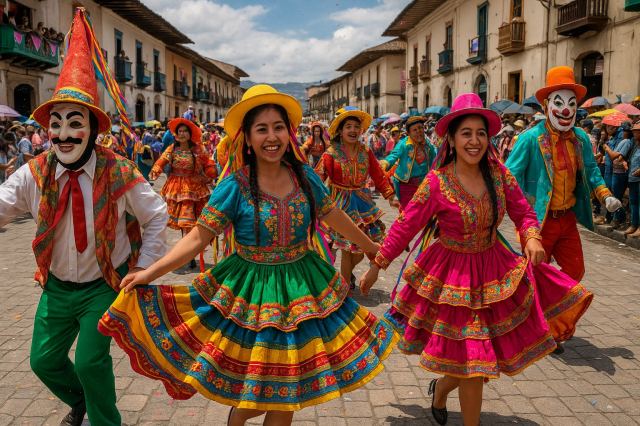Carnival is one of the most anticipated celebrations of the year throughout Peru. From the Andes to the jungle, the streets are filled with music, color, water, and talcum powder, in a blend of popular joy and ancient tradition. Although many associate Carnival with fun and games, in Peru this festivity has deep roots connected to Andean history, identity, and worldview.
Each region of the country has its own unique way of celebrating. Cajamarca hosts the largest and most famous festival, but Puno, Ayacucho, Cusco, Amazonas, and other regions also celebrate carnivals with unique cultural richness.
Origin of the carnival in Peru
Peruvian Carnival has both European and indigenous influences. It arrived with the Spanish during the Colonial period, but was quickly adapted by local communities, who blended it with their own agricultural celebrations, fertility rituals, and thanksgiving to Pachamama. Therefore, Carnival in Peru not only marks the beginning of the Christian season of Lent, but also a time of renewal and abundance for rural families.
When are carnivals celebrated in Peru?
The Peruvian Carnival is celebrated between February and March, depending on the liturgical calendar. The festivities typically last several days and often extend for weeks, especially in cities where tourism is important. In some places, the celebrations even begin with the "pre-carnival" as early as January.
🎉 Main carnivals in Peru
Below, we present the country's most vibrant and representative carnivals , ideal for exploring Peru's cultural diversity.
Cajamarca Carnival: the most famous in Peru
Considered the most important Carnival in the country , the Cajamarca Carnival is a true explosion of color and joy. For nearly two weeks, the city is transformed with parades, patrols, dances, and street parades to the rhythm of traditional bands.
Among its notable characters are King Momo , the Ño Carnavalón , and the Carnival queens , symbols of the festive spirit. There are also song-singing competitions, float parades, and the traditional "unsha" (decorated tree cut down at the end of the festival).
📅 Approximate date: February
📍 Location: Cajamarca
🎶 Attractions: Patrol and troupe competition, carnival songs, costume ball, queen election.
👉 Learn more about this region at https://www.calendarioperu.com/blog/turismo-en-cajamarca
Puno Carnival: dance, devotion and celebration
The Puno Carnival is celebrated a few days after the Feast of the Virgin of Candelaria , a UNESCO Intangible Cultural Heritage of Humanity. Although the two events are distinct, they share the same festive and devotional spirit.
During Carnival, communities in the region hold parades, dance competitions, and food festivals. Joy spreads through the streets of the highlands and Lake Titicaca, where groups display glittering costumes and handmade masks.
📅 Date: Mid-February
📍 Location: Puno
🎶 Attractions: Altiplano dances, comparsa competitions, food festivals, and craft fairs.
🧭 Related link: https://www.calendarioperu.com/blog/virgen-de-la-candelaria
Ayacucho Carnival: color and tradition in the Andes
The Ayacucho Carnival is famous for its elegance and traditional dances. The streets are filled with troupes performing huaynos, carnival songs, and contradanzas in traditional hand-embroidered costumes. Ayacucho's couplets, full of wit and humor, are an essential part of this celebration.
A notable custom is the gathering of rural and urban groups , which reflects the cultural union between the countryside and the city. Traditional dishes, such as Ayacucho puchero and chicha de jora , are also a must.
📅 Date: February
📍 Location: Ayacucho
🎶 Attractions: Parade of comparsas, singing of coplas, craft fair and typical gastronomy.
Cusco Carnival: a legacy of joy and symbolism
In Cusco, Carnival is filled with ancestral elements. Residents of rural districts perform rituals of gratitude to the land and organize yunzas (gift trees). Traditional games with water and talcum powder are also practiced, although in recent years, responsible practices have been encouraged.
The most popular dances are the Qhapaq Qolla , the Saqra , and the Qhapaq Negro , accompanied by quena and drum music. In Cusco, tourists can participate in food festivals and comparsa competitions.
📅 Date: February
📍 Location: Cusco and surrounding provinces
🎶 Attractions: Yunzas, traditional dances, food fairs.
🔗 Related: https://www.calendarioperu.com/blog/turismo-en-cusco
San Martín Carnival: Amazonian joy
In the Peruvian jungle, the San Martín Carnival combines tropical warmth with the energy of jungle music. Its main symbol is the "humisha," a tree decorated with gifts and fruit that couples cut while dancing to the rhythm of gangs and cumbia.
During the festival, traditional dance competitions, regional food fairs, and sports competitions are held. It is one of the most joyful and participatory celebrations in eastern Peru.
📅 Date: February
📍 Location: Tarapoto, Moyobamba and other provinces of San Martín
🎶 Attractions: Humisha, gangs, Amazonian gastronomy.
👉 Learn more about Amazonian festivals at https://www.calendarioperu.com/blog/fiestas-en-la-selva
Abancay Carnival: the carnival of love
The Abancay Carnival , in Apurímac, is known as the Carnival of Love because of the themes of its songs and parades. The festival is notable for its romantic verses , float parades, and the traditional yunza .
In addition, a Carnival Queen is elected, and traditional dance and food competitions are held. Its festive atmosphere attracts thousands of local and international visitors each year.
📅 Date: February or March
📍 Location: Abancay, Apurímac
🎶 Attractions: Yunzas, couplets, float parades.
Other notable carnivals in Peru
In addition to those mentioned, there are many other local carnivals with enormous cultural wealth:
Juliaca Carnival (Puno) – Known for its sicuris music.
Huánuco Carnival – Famous for its “negritos” (black people) troupes.
Catacaos Carnival (Piura) – Combines tradition and popular celebration with parades and Creole music.
Moyobamba Carnival (San Martín) – Includes food fairs and gang competitions.
Tumbes Carnival – With tropical music and celebrations by the sea.
🌺 Customs and symbols of the Peruvian carnival
The yunza or cortamonte: Tree decorated with gifts, fruits and streamers.
Coplas: Verses sung with humor and mischief that reflect everyday life.
Water and talcum powder: Traditional games that symbolize purification and joy.
The costumes: They represent typical characters, animals or mythological figures.
Gastronomy: Dishes such as puchero, chicha de jora and tamales are the stars.
